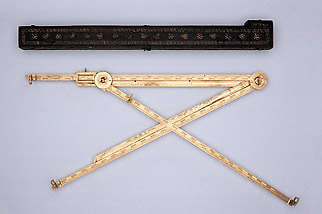
 |
| Catalogue |
 |
 Triangulation Instrument The mount for a pivot for a third arm slides along the baseline arm, with a handle, a rectangular aperture for reading its position on the scale, and is marked with the letter 'F'. The circular end of the third arm is secured to this moving mount by a washer and wing nut, which forms a clamping pivot. The third arm carries a scale similar to the other two, marked 'D' and 'E' at either end, and slit and window sights, the position of the former marked '3' on the arm. The second upper surface of the baseline arm has a 'PLVMBVM' scale 1 to 100 decreasing, divided to 10, subdivided to 5 with alternate hatching and mirror gilding, and to 1, numbered by 10, except that from 1 to 10 the pattern alternates for every unit and the numbering is to 1. The second upper surface of the moving arm has a similarly divided scale marked 'FERRVM'. Underneath the third arm is a third scale for shot, similarly divided and marked 'LAPIS'. The verso sides of the two main arms have 4 ont-foot scales, each divided to 1 inch, while each inch in divided into 1, 2, 3, etc to 12 parts, numbered by 1 inch. They are marked 'PES ROMANVS', 'PES VIENNENSIS', 'PPES PRAGENSIS' and 'PES NORNBERGENSIS' The clamping washer for the moving pivot is a disc cur from a sheet of copper with part of a scale and the number '160' visible. Signed on the inner edge of the baseline arm: 'Fecit Erasmus habermel'. Shapes wooden box, lined with silk and covered with leather with gold tooling. J. Bennett and S. Johnston, The Geometry of War 1500-1750 (Oxford, 1996) Jim Bennett |



